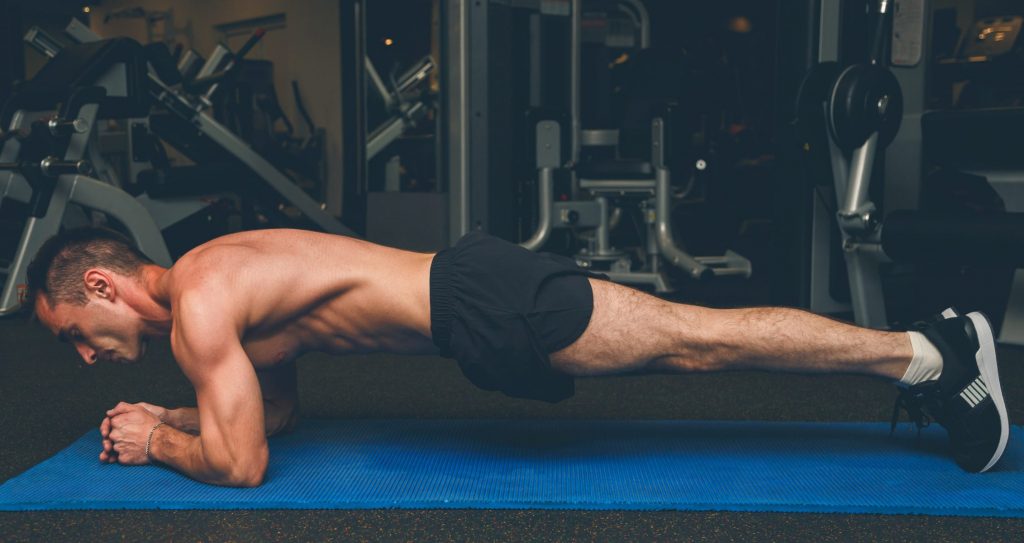Plank drags engage other muscle groups to challenge your core and stability extensively.
The plank is a powerful isometric exercise for the abs (1), engaging your core muscles through intense contraction for optimal stimulation. An advanced variation, the plank drag, elevates the traditional plank by combining isometric and isotonic contractions, enhancing its effectiveness.
To be clear, there’s nothing wrong with performing the plank independently. However, it can become monotonous, making an additional 30 seconds seem endless. The plank drag can enhance the activity using a weight plate, dumbbell, or kettlebell.
Due to the added weight, the plank drag is a more challenging variation that works on your arms, shoulders, core, back, and legs. In this exercise guide, you’ll learn how to do the plank drag in the correct form to build a shredded core. You’ll also see more benefits of this routine and some good alternatives you can try.
Techniques & Muscles Worked
The plank drag mainly targets your abs while engaging other muscles like your delts, biceps, pecs, back, hamstrings, and glutes to perform it. In addition, this exercise will work on your hip hinge and core stability.
You can use any light object as a weight to do the plank drag. This exercise guide highlights plank drags utilizing a kettlebell. Below is a step-by-step guide to doing a plank drag using a kettlebell.
- Get in the high plank pose and place the kettlebell behind your left wrist.
- Engage your quads, abs, glutes, and shoulders, and then move your right hand under you to grab the kettlebell.
- Drag it over to your right side and place it behind your right wrist.
- Return your right hand to its original position on the elbows.
- Repeat steps 2-4 using your left hand to return the kettlebell to your left side and complete the rep.
- Repeat for multiple reps.
Benefits
The plank drag engages your core muscles more extensively, contributing to your overall strength levels. Below are some key benefits to expect from this routine.
Increased Core & Upper Body Strength
The plank drag activates your entire core, including some deep stabilizer muscles. This exercise also engages your chest, shoulders, and arm muscles. As a result, doing plank drags will increase your core and upper body strength over time.
Better Coordination & Balance
Doing the plank will test your balance. Plank drags, especially with kettlebells, will test your stability even more to enhance your coordination and balance.
Improved Posture
Many people have bad postures due to their hours hunched over laptops and phones. The plank drag forces you to hold your body straight and strengthens your posterior chain muscles. As a result, your posture will improve.
Low Strain
The plank drag isn’t too tasking on the joints. This is because you’ll be on all fours for the routine. Thus, the impact on your joints will be minimal.
Versatility
You can do the drag part of your plank drag faster with a light weight for cardio. Or you can lift heavier and slow down your routine to turn it into strength training.
Functionality
Rather than just staying stationary, the plank drag is more dynamic. As a result, it better mimics real-life movements. Getting better at this movement will lead you to carry out your daily activities more efficiently.
Plank Drag Alternatives
The plank drag is a great way to progress regular planks. However, it’s essential to vary your exercise to prevent training monotony, so it should not be your only option (2). Below are some other great movements that you can include in your workouts.
Plank Shoulder Tap
The plank shoulder tap is a plank variation that looks easy but is quite challenging. This bodyweight exercise will help you improve stability and coordination. Remember to keep a neutral shoulder when doing the plank shoulder tap.
Renegade Row
The renegade row is an effective back and core-building exercise. It involves doing a row with dumbbells while planking. For the best results with this routine, ensure that your torso stays parallel when doing this routine.
Banded Plank Walk
If you’re at home and don’t have access to dumbbells or kettlebells, how about using resistance bands for a banded plank walk? This exercise is also a great ab builder, but be wary as it’s an advanced routine. Research shows resistance bands can enhance power and strength (3).
FAQs
What is the plank drag?
Plank drags are also called plank pull throughs and are an effective ab-building routine. It’s more advanced than the traditional plank and uses weights and movement to increase the effect on your muscles.
What are the benefits of the plank drag?
Plank drags add dynamic movement to the stationary plank, making it more challenging. For more benefits, check the exercise guide above.
Do planks burn belly fat?
Planks don’t help you burn belly fat directly. They will, however, allow you to work on building and strengthening your core muscles and abs. These will show up after you’ve lost the fat around them through physical activity and dietary changes.
Follow us on Instagram, Facebook, and Twitter for more exercise guides!
References
- Youdas, J. W., Coleman, K. C., Holstad, E. E., Long, S. D., Veldkamp, N. L., & Hollman, J. H. (2018). Magnitudes of muscle activation of spine stabilizers in healthy adults during prone on elbow planking exercises with and without a fitness ball. Physiotherapy theory and practice, 34(3), 212–222. https://doi.org/10.1080/09593985.2017.1377792
- Krzysztofik, M., Wilk, M., Wojdała, G., & Gołaś, A. (2019). Maximizing Muscle Hypertrophy: A Systematic Review of Advanced Resistance Training Techniques and Methods. International journal of environmental research and public health, 16(24), 4897. https://doi.org/10.3390/ijerph16244897
- Joy, J. M., Lowery, R. P., Oliveira de Souza, E., & Wilson, J. M. (2016). Elastic Bands as a Component of Periodized Resistance Training. Journal of strength and conditioning research, 30(8), 2100–2106. https://doi.org/10.1519/JSC.0b013e3182986bef








